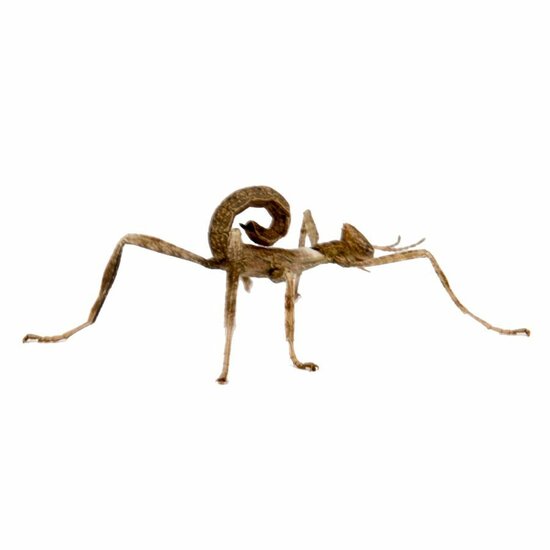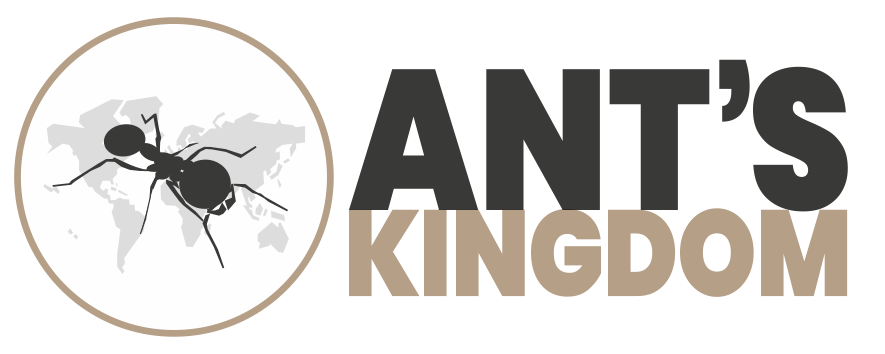

- Ants as pets since 2009 It starts here!
- We ship every working day until 4:30 PM
- Flat shipping costs from €6.99
- Specialists in ants, free advice
Do you have questions about this product?
Or do you need help? Please feel free to contact us, we are happy to help!
Product description
PSG 9 Nymph Australian giant prickly stick insect
1 nymph of the Australian stick insect. The gender of the nymphs is not always visible.
General information
A few weeks old stick insects of the species Extatosoma tiaratum. This is also called the Macleays Spectre Stick Insect. The species has also received the number psg 9.
The stick insect is native to Australia and New Guinea and is very popular because of its unusual shapes and size. They look more like a cactus than a branch. They have spines and striking bulges on the legs. They are often stained brown, and occasionally there are also green varieties of this type available. In the pictures above you can see how beautiful they are!
What is striking is the large difference between males and females. The females are thick, prickly and 15 cm long. Males are just narrow with long wings, little spines and a length of about 12 to 13 cm.
Movement and behavior
This walking stick is a peaceful animal. Because most stick insects are nocturnal, they will not show much movement during the day. In the evening you can see they do move and eat.
Nutrition
This species eats several leaves like blackberry leaves, raspberry leaves, oak leaves, rose leaves, hazel and eucalyptus leaves. Blackberry leaves are easy found even in winter. Provide unsprayed food!
The nymphs are raised with us with blackberry leaf, so we recommend using these type of leaves for the nymph. You can also mix different leaves (but in any case blackberry) so they can get used to another type of blade.
Environmental conditions
The temperature may vary between 20 ° C and 30 ° C. Room temperature is fine for these animals.
The stick insect does not make high demands on the humidity, make sure you spray atleast 2-3 times per week, as they need water for survival. watch out for mold development.
As with all kinds of walking sticks, the sticks require a stay of at least 3 times the length of the animal high, wide and at least 2 times the length of the animal. For an adult female this means an amount of at least 45 cm high and 30 cm wide.
Reproduction
Adult males are distinguishable because they are smaller, have wings and long antennae.
This species can reproduce sexually or parthenogenetic. You can keep the males and females together in a stay. The eggs are round brown balls.
The eggs hatch after about 4 to 6 months if a male has fertilized the female, parthenogenetic eggs hatch after six months to a year pass out. Keep the eggs on a damp paper. This should always be moist but not really wet. Most preferably, keep the eggs at a temperature of 25 ° C. Beware for mold!
Home-grown
The stick insects are bred by us and will only be sent by parcel post. Sex is not visible yet. Have fun observing these amazing animals!
PSG 9 Nymph Australian giant prickly stick insect
1 nymph of the Australian stick insect. The gender of the nymphs is not always visible.
General information
A few weeks old stick insects of the species Extatosoma tiaratum. This is also called the Macleays Spectre Stick Insect. The species has also received the number psg 9.
The stick insect is native to Australia and New Guinea and is very popular because of its unusual shapes and size. They look more like a cactus than a branch. They have spines and striking bulges on the legs. They are often stained brown, and occasionally there are also green varieties of this type available. In the pictures above you can see how beautiful they are!
What is striking is the large difference between males and females. The females are thick, prickly and 15 cm long. Males are just narrow with long wings, little spines and a length of about 12 to 13 cm.
Movement and behavior
This walking stick is a peaceful animal. Because most stick insects are nocturnal, they will not show much movement during the day. In the evening you can see they do move and eat.
Nutrition
This species eats several leaves like blackberry leaves, raspberry leaves, oak leaves, rose leaves, hazel and eucalyptus leaves. Blackberry leaves are easy found even in winter. Provide unsprayed food!
The nymphs are raised with us with blackberry leaf, so we recommend using these type of leaves for the nymph. You can also mix different leaves (but in any case blackberry) so they can get used to another type of blade.
Environmental conditions
The temperature may vary between 20 ° C and 30 ° C. Room temperature is fine for these animals.
The stick insect does not make high demands on the humidity, make sure you spray atleast 2-3 times per week, as they need water for survival. watch out for mold development.
As with all kinds of walking sticks, the sticks require a stay of at least 3 times the length of the animal high, wide and at least 2 times the length of the animal. For an adult female this means an amount of at least 45 cm high and 30 cm wide.
Reproduction
Adult males are distinguishable because they are smaller, have wings and long antennae.
This species can reproduce sexually or parthenogenetic. You can keep the males and females together in a stay. The eggs are round brown balls.
The eggs hatch after about 4 to 6 months if a male has fertilized the female, parthenogenetic eggs hatch after six months to a year pass out. Keep the eggs on a damp paper. This should always be moist but not really wet. Most preferably, keep the eggs at a temperature of 25 ° C. Beware for mold!
Home-grown
The stick insects are bred by us and will only be sent by parcel post. Sex is not visible yet. Have fun observing these amazing animals!
More information...
If you have any questions, please don't hesitate to contact us, we like it! You can reach us via email and WhatsApp. You are welcome in the showroom by appointment for advice and purchase!
Customer service Make an appointment
